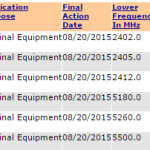By way of the FCC, we learn something that looks like a third generation Nest Theromostat is en route… with 5GHz joining the party. Now I can’t say for certain the unnamed Nest device is another learning thermostat. But the round profile, with label on back, identified as model ZQAT30 (versus the 2nd gen’s ZQAT20) sure seems suggestive.
As the test firm received their sample back in April, but there was no mention of a thermostat refresh at Nest’s June press event, I’ll go ahead and assume some production or engineering kinks have delayed an announcement. As to additional features, beyond new wireless capabilities, no remote sensors have popped (unless that’s what this is)… which has become something of a shortcoming compared to the highly regarded (and now HomeKit-compatible) ecobee t-stat.


I would hope that this still remains 2.4GHz as well, but I don’t know if I understand why they would add 5GHz unless it just happens to be supported by the chipset they are using — its not like your thermostat needs lots of bandwidth — its not streaming video. I’m pretty sure a Nest would do fine with a 802.11B connection at <10mb/s. I would almost thing 5GHz would be a disadvantage because it doesn't have the same range as 2.4 — I can easily get 2.4GHz connections throughout my house while 5GHz is much weaker as you get farther away from the router.
Yes, look at the top right image – 2.4GHz is represented as well. As to why, well it may depend upon what the product really is. Your chipset thought is reasonable, should it be another thermostat. But what if it’s also a Weave Brillo hub in addition to a thermostat?
As to me, I have a 2nd gen Nest installed downstairs, but haven’t yet replaced the typical Honeywell programmable model upstairs. ecobee seems more well rounded, with those remote sensors and HomeKit, but messing with the wiring inside the AC machine makes us uncomfortable. Hm. Wonder if this might be my upstairs answer.
Are Nest thermostats even programmable the way standard thermostats are? I honestly don’t get this device or how it saves people a significant amount of money. I have a Honeywell thermostat that has 4 programmable options/times per day and can be adjusted for each day of the week.
I don’t need or want my thermostat guessing if I’m home. We like it cold when we’re sleeping so the AC stays on at night in the summer and the heat is off at night in the winter. My wife works at night sometimes so then the AC stays on at a lower temperature than normal during the day when she’s sleeping. None of this seems easily doable with the Nest.
Yes, it’s entirely programmable – but instead of four time windows, you can adjust hour by hour on any given day. Although it tries to set a schedule based on your patterns and every now and then you’ll step on each other’s toes. See pic here:
http://support-assets.nest.com/images/000001188/web-app-schedule.png
Auto-away hasn’t been super accurate for me, but manually flipping it to Away mode is useful. And when i forget to do it at home, I can do it from the car. Speaking of car, when I land at the airport, I turn Away off so temperature is a little better when I get home. I do like changing temp from bed or couch and “airwave” to circulate cool air instead of running another few minutes is a nice automatic feature.
As to saving money, who knows.
I’ve quite often done the airport toggle for the Nest, but the ecobee has a what I think is an even better feature where I can just tell it when I’m going to be on vacation and it will know when to resume its program. I don’t quite understand why Nest doesn’t have such thing — even my old programmable Honeywell allowed me to set how many days my vacation would last – though the ecobee has a much more user friendly interface for that.
As far as the auto-away feature, it works okay if its in a high-traffic area — but as you mentioned — remote sensors would be even better.
As to @Daniel — I think part of the savings that Nest promotes are due to the fact that many people even with programmable thermostats don’t tend to program them. Some of them are not too bad to program (Honeywell) but the one my mom has (no idea what brand) is not at all user friendly to program. I think 90% of the time I’m at my mom’s house, its set to a temperature with the “hold” setting overriding any programming (which was probably set by the HVAC person who installed it). The Nest does away with this because you just walk by, set what you want the temperature to be and it will eventually generate a schedule on its own. I don’t think that the Nest saves (much) money for someone who is comfortable setting their thermostat’s schedule. I got the Nest (and now ecobee since I have 2 different systems) mostly for the wifi functionality – plus the fact that MA has a $100 rebate for wifi thermostats makes them reasonable vs. a programmable model.
Interesting. I was just about to pull the trigger and add another 1 or 2 nest thermostats to my setup.
I have a 4 heat zones. 1 Nest Thermostat, and 4 2nd gen Nest Protects. I’d like to add atleast another thermostat but will wait a few more months to see if anything pans out with a new Nest.
Michael,how often can you qualify for that $100 rebate? Is it one time only per address or can you qualify again say every 5-10 years?
I think it said 2 thermostats/year when I filled out the rebate (I assume per address). It may only be valid if you have gas heating but I’m not certain. I filled out the form through http://www.gasnetworks.com/ but it may just be because the site I was using said “go here” if this is your provider.
Probably have 5 GHz as that’s where 802.11ac is. Most Wi-Fi enabled devices are migrating to the newest standard (as well as being backwards compatible w/older tech like 802.11n, which does work in the the 2.4 GHz band.
Yeah, the Wifi functionality is nice. I did actually buy a Wifi Honeywell model 2 years ago when I added a Central AC zone in my house. It’s also helpful when we go away and forget to turn the think down.
Costco had some WiFi Honeywells about the time I picked up my Nest for less than half the investment. But the way it was written up, I didn’t know how or if it’d route beyond the home and if they’d eventually charge for the service. Also the Nest was sexier, so I partially wrote it off as wall art.
I wouldn’t want to use 5Ghz WiFi with my Nest since the range is so much shorter. While it would work since I use four APs to make sure I get excellent signal strength on every device from 2.4Ghz and 5Ghz. I typically use 5Ghz for my devices that do a lot of streaming. Like my IP cameras that stream 24/7/365.
And I only want my utility devices to connect to my main router, which is farther away and on a UPS to give it up to 18 hours of runtime. So with 2.4Ghz I get an excellent signal from that router but at 5Ghz it would be a low signal.
“I wouldn’t want to use 5Ghz WiFi with my Nest since the range is so much shorter.”
That was my exact initial thought. Sounds good for marketing. Makes zero sense in reality.
2.4 is congested. If connections can use 5GHz, they should. They can always fall back to 2.4.
Also not mentioned, this model has 80.15.4 which is usually used for Zigbee. This bodes well for remote sensors.
The prior two models had the hardware to support Zigbee or Zwave… but was never implemented. At least that is my recollection.
“2.4 is congested. If connections can use 5GHz, they should. They can always fall back to 2.4.”
No doubt that 2.4 is congested. I live a very-high-density metro environment, and my 2.4 is far more congested than most. But still, for low data rate exchange, even in a heavily congested environment, 2.4Ghz is a much more reliable connection than 5Ghz out of direct line-of-sight from the antenna. For low data rate exchange within direct line-of-sight from the antenna, it’s still only a wash!
No doubt that having 5GHz as a fallback doesn’t hurt, but in real-world practice for a thermostat, it really doesn’t help one whit either. Good for marketing. Zero help for users in reality.
In short, there just aren’t scenarios where 5Ghz would help for a thermostat. (There are a multitude of excellent use-cases for 5Ghz, this just isn’t one of them.)
hmmm….all my devices connected over 5Ghz uses 2.4Ghz as a fallback. Not the other way around.
“hmmm….all my devices connected over 5Ghz uses 2.4Ghz as a fallback. Not the other way around.”
Of course. Why wouldn’t they? 5Ghz has much higher throughput under optimal infrastructure placement circumstances. And higher throughput matters a lot for anything that isn’t exclusively doing low data rate exchange.
But which is ‘primary’ and which is ‘fallback’ doesn’t matter in practice in this particular scenario. A 5Ghz enabled Nest is going to end up connecting over 2.4Ghz in most use-cases. (And, again, even if the infrastructure placement enables a good 5Ghz connection, it’s not going to help out in practice for a thermostat, due to the lack of need for higher throughput.)
How long before we can expect to see this new model for purchase?
I’d like to buy another best before November.
@Jeff — looks like today: http://gizmodo.com/nests-got-a-new-thermostat-1727850745
hmmm…40% bigger screen?? I definitely don’t need a bigger screen. It’s already a good size right now.(Although I rarely touch the actual Thermostat any more. I usually access it through my phone, tablet, or pc) Of course my current second gen NEST has been working fine. So hopefully it continues to do so.
Pretty boring announcement… A nice upgrade for those new to the fold, but there’s not much here to compel many to upgrade. I choose to assume there are dormant features and functionality awaiting other moving pieces. We shall see.
“Pretty boring announcement… A nice upgrade for those new to the fold, but there’s not much here to compel many to upgrade.”
How on Earth can you possibly say that?
5Ghz has more than twice the Ghz that 2.4Ghz does. Total game changer.
Awesome! Now that it has this clock farsighted feature, I’m going to put one in every room!